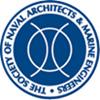Multi-fidelity Bayesian Optimization of SWATH Hull Forms
IF 1
4区 工程技术
Q3 ENGINEERING, CIVIL
引用次数: 8
Abstract
This study presents a multi-fidelity framework that enables the construction of surrogate models capable of capturing complex correlations between design variables and quantities of interest. Resistance in calm water is investigated for a SWATH hull in a multidimensional design space using a new method to derive high-quality response surfaces through machine learning techniques based on a low number of high-fidelity computations and a larger number of less-expensive low-fidelity computations. First, a verification and validation study is presented with the goal of comparing and ranking numerical methods against experiments performed on a conventional SWATH geometry. Then, the hull geometry of a new family of unconventional SWATH hull forms with twin counter-canted struts is parametrically defined and sequentially refined using multi-fidelity Bayesian optimization. Ship resistance in calm water is finally predicted using observations from two different fidelity levels. We demonstrate that the multi-fidelity optimization framework is successful in obtaining an optimized design using a small number of high-fidelity computations and a larger number of low-fidelity computations. Simulation and optimization costs are reduced by orders of magnitude, providing accurate certificates of fidelity for the performance of the proposed design.SWATH船型的多保真度贝叶斯优化
本研究提出了一个高保真度框架,该框架能够构建能够捕捉设计变量和感兴趣数量之间复杂相关性的代理模型。在多维设计空间中,使用一种新方法,通过基于少量高保真度计算和大量不太昂贵的低保真度计算的机器学习技术,推导出高质量的响应面,研究了SWATH船体在平静水中的阻力。首先,进行了验证和验证研究,目的是将数值方法与在传统SWATH几何结构上进行的实验进行比较和排序。然后,使用高保真度贝叶斯优化对一类新的具有双对角支柱的非常规SWATH船型的船体几何结构进行了参数化定义和顺序精化。通过两个不同保真度水平的观测,最终预测了平静水中的船舶阻力。我们证明了高保真度优化框架使用少量高保真度计算和大量低保真度计算成功地获得了优化设计。模拟和优化成本降低了几个数量级,为拟议设计的性能提供了准确的保真度证书。
本文章由计算机程序翻译,如有差异,请以英文原文为准。
求助全文
约1分钟内获得全文
求助全文
来源期刊

Journal of Ship Research
工程技术-工程:海洋
CiteScore
2.80
自引率
0.00%
发文量
12
审稿时长
6 months
期刊介绍:
Original and Timely technical papers addressing problems of shipyard techniques and production of merchant and naval ships appear in this quarterly publication. Since its inception, the Journal of Ship Production and Design (formerly the Journal of Ship Production) has been a forum for peer-reviewed, professionally edited papers from academic and industry sources. As such, it has influenced the worldwide development of ship production engineering as a fully qualified professional discipline. The expanded scope seeks papers in additional areas, specifically ship design, including design for production, plus other marine technology topics, such as ship operations, shipping economic, and safety. Each issue contains a well-rounded selection of technical papers relevant to marine professionals.
 求助内容:
求助内容: 应助结果提醒方式:
应助结果提醒方式:


